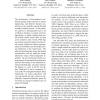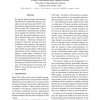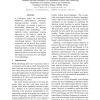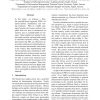ACL
2015
9 years 9 months ago
2015
The performance of discriminative constituent parsing relies crucially on feature engineering, and effective features usually have to be carefully selected through a painful manua...
96
Voted
ACL
2015
9 years 9 months ago
2015
We present paired learning and inference algorithms for significantly reducing computation and increasing speed of the vector dot products in the classifiers that are at the hea...
ACL
2015
9 years 9 months ago
2015
How do we build a semantic parser in a new domain starting with zero training examples? We introduce a new methodology for this setting: First, we use a simple grammar to generate...
102
click to vote
ACL
2015
9 years 9 months ago
2015
Traditional approaches to word sense disambiguation (WSD) rest on the assumption that there exists a single, unambiguous communicative intention underlying every word in a documen...
ACL
2015
9 years 9 months ago
2015
Constituent parsing is typically modeled by a chart-based algorithm under probabilistic context-free grammars or by a transition-based algorithm with rich features. Previous model...
ACL
2015
9 years 9 months ago
2015
A joint-space model for cross-lingual distributed representations generalizes language-invariant semantic features. In this paper, we present a matrix cofactorization framework fo...
ACL
2015
9 years 9 months ago
2015
Traditional learning to rank methods learn ranking models from training data in a batch and offline learning mode, which suffers from some critical limitations, e.g., poor scalab...
ACL
2015
9 years 9 months ago
2015
Deception detection has been formulated as a supervised binary classification problem on single documents. However, in daily life, millions of fraud cases involve detailed conver...
ACL
2015
9 years 9 months ago
2015
This paper is the first to examine the effect of prosodic features on coreference resolution in spoken discourse. We test features from different prosodic levels and investigate ...
ACL
2015
9 years 9 months ago
2015
In this paper, we propose a flexible principle-based approach (PBA) for reader-emotion classification and writing assistance. PBA is a highly automated process that learns emoti...




